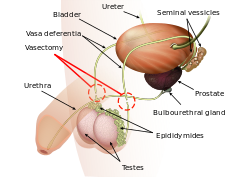Vasectomy
| Vasectomy | |
|---|---|
 |
|
| Background | |
| Type | Sterilization |
| First use | 1899 (experiments from 1785) |
| Failure rates (first year) | |
| Perfect use | 0.10% |
| Typical use | 0.15% "Vas-Clip" nearly 1% |
| Usage | |
| Duration effect | Permanent |
| Reversibility | Possible, but expensive. |
| User reminders | Two consecutive negative semen specimens required to verify no sperm. |
| Advantages and disadvantages | |
| STI protection | No |
| Benefits | No need for general anesthesia. Lower cost/less invasive than tubal ligation for women. |
| Risks | Temporary local inflammation or swelling of the testes. Long-term genital pain (PVPS). |
Vasectomy is a surgical procedure for male sterilization or permanent contraception. During the procedure, the male vas deferens are severed and then tied or sealed in a manner so as to prevent sperm from entering into the ejaculate and thereby prevent fertilization. Vasectomies are usually performed in a physician's office, medical clinic, or, when performed on an animal, in a veterinary clinic— hospitalization is not normally required as the procedure is not complicated, the incisions small, and the necessary equipment routine.
There are several methods by which a surgeon might complete a vasectomy procedure, all of which occlude (i.e. "seal") at least one side of each vas deferens. To help reduce anxiety and increase patient comfort, men who have an aversion to needles may consider a "no-needle" application of anesthesia while the "no-scalpel" or "open-ended" techniques help to accelerate recovery times and increase the chance of healthy recovery.
Due to the simplicity of the surgery, a vasectomy usually takes less than thirty minutes to complete. After a short recovery at the doctor's office (usually less than an hour), the patient is sent home to rest. Because the procedure is minimally invasive, many vasectomy patients find that they can resume their typical sexual behavior within a week, and do so with little or no discomfort.
Because the procedure is considered a permanent method of contraception and is not easily reversed, men are usually counseled/advised to consider how the long-term outcome of a vasectomy might affect them both emotionally and physically. The procedure is not often encouraged for young single men as their chances for biological parenthood are thereby more or less permanently reduced to almost zero by it. It is seldom performed on dogs (castration, a different procedure, remains the preferred reproductive control option for canines) but is regularly performed on bulls.
A vasectomy is done to prevent fertility in males. It ensures that in most cases the person will be sterile after confirmation of success following surgery. The procedure is regarded as permanent because vasectomy reversal is costly and often does not restore the male's sperm count or sperm motility to prevasectomy levels. Men with vasectomies have a very small (nearly zero) chance of successfully impregnating a woman, but a vasectomy has no effect on rates of sexually transmitted infections.
...
Wikipedia
